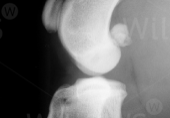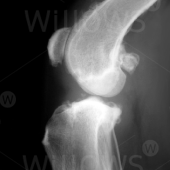Why Should I Bring my Pet to Willows for Treatment of Cranial Cruciate Ligament Deficiency (CCL)?
Willows is one of Europe’s leading small animal Orthopaedic referral centres treating over 1000 new patients a year. Our state-of-the-art hospital is led by internationally renowned Specialists committed to providing the highest standards of veterinary care. Our team of Specialist Orthopaedic Surgeons have a collective experience of treating thousands of dogs with CCL ruptures.
Our Orthopaedic Surgeons are supported by our multi-disciplinary team of Specialists across a number of disciplines including; Anaesthesia, Diagnostic Imaging and Emergency and Critical Care. Willows has a large dedicated team of Nurses and clinical support staff available 24 hours a day, every day of the year to provide the best possible care for your pet.
What is the Cranial Cruciate Ligament?
The Cranial Cruciate Ligament (CCL) is an important ligament inside the knee joints (stifle) of dogs. The ligament stabilises the stifle by preventing the shin bone (tibia) moving in front of the thigh bone (femur).
In dogs the CCL tends to undergo progressive changes that weaken it prior to rupturing. This is different to humans, where rupture is often linked with a sports injury i.e. skiing or playing football. Due to these differences the treatment options for dogs are quite different to those for humans.

What are the Signs of Cranial Cruciate Ligament Rupture?
The signs of CCL rupture can vary as rupture may be sudden and complete, or gradual and partial. Key signs include:
- Lameness in the hind limbs and stifle
- Knee joint pain
- Difficulty rising and jumping
- Occasionally ‘clicking’ noises.
Fig 1: X-ray of a dog’s knee without arthritis


What are the Signs of Cranial Cruciate Ligament Rupture?
During examination signs of muscle wastage may be uncovered, especially over the front of the thigh (the quadriceps muscles). Thickening of the knee joints is often noticeable. Through manipulation of the joint it may be possible to detect instability, whilst bending and extension of the joint may cause discomfort.
X-rays provide additional information during diagnosis, and can help to identify the presence and severity of osteoarthritis.
For some dogs it may be necessary to take a sample of fluid from the knee, which enables the detection of any inflammatory changes such as infection or rheumatoid arthritis.
In some dogs more advanced tests are used to diagnose the problem, such as arthroscopy of the joint, however these advanced procedures are rarely necessary.
Fig 2: X-ray of a dog’s knee with arthritis
How can Cranial Cruciate Ligament Rupture be Treated?
Some smaller dogs with CCL rupture can be managed effectively without the need for surgery; this may be done through:
- Exercise: this needs to be restricted, hydrotherapy is often beneficial
- Diet: dogs that are overweight benefit from being placed on a diet
- Medication: painkillers may be suggested to make the dog more comfortable
Many smaller dogs and almost all larger dogs with CCL rupture benefit from surgery. There are four main forms of surgery:
- CCL Replacement Surgery – Traditionally, surgery has been performed to replace the ligament with either a graft or an artificial ligament. However, the long-term stability of this is uncertain and so alternative operations have now been developed.
- Tibial Plateau Levelling Osteotomy Surgery (TPLO) – TPLO involves changing the angle of the top of the shin bone (the tibial plateau) by cutting the bone, rotating it, and stabilising it in a new position with a plate and screws.
- Tibial Tuberosity Advancement Surgery (TTA) – TTA involves cutting the front of the shin bone, moving it forward, and stabilising it in a new position with a plate and screws.
- Meniscal (cartilage) Surgery – Cartilage injury, as with humans, can cause significant pain and lameness and so the damaged section needs to be removed. This can be performed by standard surgery which is often key-hole, or arthroscopically using a camera. Recovery after meniscal surgery is usually very rapid.
What can I Expect if my Dog is Treated for Cranial Cruciate Ligament Rupture?
Exercise following surgery must be restricted for the first few weeks during the healing process. After a few weeks, controlled exercise (on a lead) may be gradually increased and hydrotherapy may be recommended. The outlook after surgery is generally good especially with some of the more modern procedures such as TPLO.
In the long term all dogs with CCL rupture develop osteoarthritis of the stifle joint; this may require ongoing management and in some dogs can result in permanent lameness. For some dogs further surgery, such as a total knee replacement can be considered, however it is very uncommon for this to be needed.
To save this page as a PDF, click the button and make sure “Save as PDF” is selected.
Orthopaedics
Find out more
To assist owners in understanding more about Orthopaedics we have put together a range of information sheets to talk you through the some of the more common orthopaedic conditions seen and treated by our Specialists.

